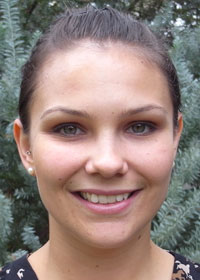![An Australian Government Initiative [logo]](/images/austgovt_canbr_90px.gif)

![An Australian Government Initiative [logo]](/images/austgovt_canbr_90px.gif) |
 |
|
NAME
|
Lydia K. GujaPh.D., Curtin University, 2014 B.Sc.(Hons), University of Western Australia, 2007 |
 |
|
CONTACT
|
Email: Lydia.Guja Phone: (+61) 2 6250 9471 Postal address: Australian National Botanic Gardens, GPO Box 1777, Canberra, ACT 2601 Street address: Australian National Botanic Gardens, Clunies Ross St, Acton, ACT 2601
|
|
|
PROJECT
INTERESTS |
With a focus on Australian native seeds Lydia investigates seed conservation biology, threatened species conservation, endangered species and communities, seed ecology, seed dispersal, seed physiology, ecophysiological germination thresholds, stress tolerance, and landscape restoration.
The Seed Conservation Biologist plays a key role in developing and monitoring the strategic direction and scientific goals of the National Seed Bank at the Australian National Botanic Gardens and expanding existing seed banking and research activities. |
|
|
SELECTED
PUBLICATIONS |
Wuhrer, R., Guja, L.K., Merritt, D.J. & Moran, K. (2014), X-Ray mapping investigations of salt migration in seeds through use of window and windowless silicon drift detectors. Microscopy and Microanalysis. 20 (Suppl. 3): 634–635. Guja, L.K., Merritt, D.J., Dixon, K.W., & Wardell-Johnson, G. (2014), Dispersal potential of Scaevola crassifolia (Goodeniaceae) is influenced by intraspecific variation in fruit morphology along a latitudinal environmental gradient. Australian Journal of Botany. 62(1): 56–64. Guja, L.K., Wuhrer, R., Moran, K., Dixon, K.W., Wardell-Johnson, G., & Merritt, D.J. (2013), Full spectrum X-ray mapping reveals differential localisation of salt in germinating seeds of differing salt tolerance. Botanical Journal of the Linnaean Society. 173: 129–142. Guja, L.K,, North, T., McAuliffe, J., & Taylor, D. (2012), Sowing seeds: Bridging the gap between ex situ collections and reintroduction. Australasian Plant Conservation. 21: 14–17. Guja, L.K., Merritt, D., & Dixon, K. (2010), Buoyancy, salt tolerance and germination of coastal seeds: implications for oceanic hydrochorous dispersal. Functional Plant Biology. 37: 1175–1186. |
|
|
CURRENT
RESEARCH PROJECTS |
Lydia is undertaking a number of collaborative conservation and research projects which aim to secure collections and develop protocols to germinate seeds of threatened plants, or plants of threatened communities. Particularly, she is focusing on the EPBC listed community of ‘Alpine Sphagnum bogs and associated fens’ and the germination ecology and seed persistence of plants that form this community. |
|
|
PROJECT
SUPERVISION |
|
|